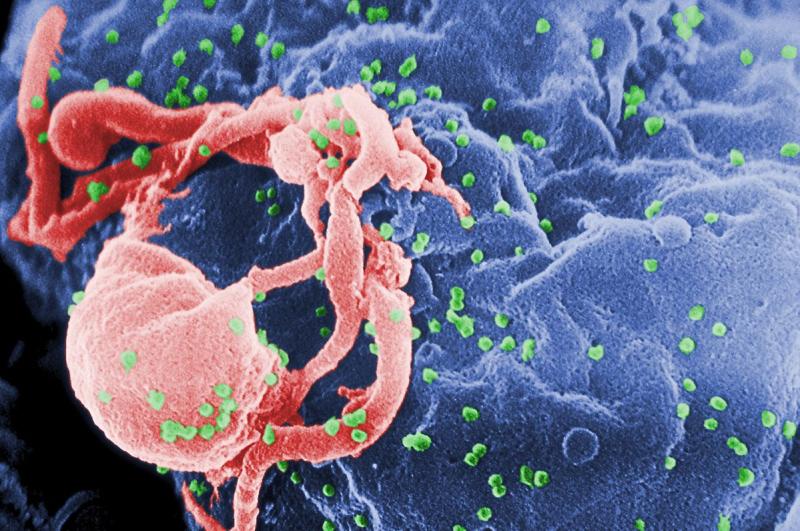Tracing the global spread of AIDS
Category: Health, Science & Technology
Via: buzz-of-the-orient • 5 years ago • 1 commentsBy: By Ma Chi


Tracing the global spread of AIDS
Since being discovered around four decades ago, AIDS/HIV has claimed the lives of more than 30 million people around the world. By the end of 2018, about 37.9 million people were living with HIV, with two-thirds of them in Africa.
Initially believed to be a "gay cancer" and spread only among homosexual men, the disease - which later become known as AIDS – caused panic among people because of the unknowns surrounding it.
As more knowledge about the disease came to light in the following years, prejudice and stigmatization related to the disease was reduced. However, it took even longer for scientists to trace its origin and understand how it spread across the world.

Students wait for their face paint to dry before an AIDS awareness rally inside a school on the eve of World AIDS Day, in Chandigarh, India, Nov 30, 2015. [Photo/Agencies]
Discovery
In 1981, the US Centers for Disease Control and Prevention published a report about five previously healthy homosexual men becoming infected with rare forms of pneumonia and cancer. This is the first time the disease, which is now known as AIDS, was recorded.

The disease was initially called "Gay-Related Immune Deficiency" because it was thought to only affect gay men.
It wasn't until mid-1982 that scientists realized the disease was also spreading among other populations, such as hemophiliacs and heroin users. By September that year, the disease was finally renamed to AIDS (acquired immune deficiency syndrome).
It was only in 1983 that the HIV was isolated and identified by researchers at the Pasteur Institute in France. In the same year, it was discovered that women can become infected with AIDS through heterosexual sex.
In 1986, it was found that HIV can be transmitted from mother to child through breast feeding.
"Patient Zero"
Gaetan Dugas, a Canadian flight attendant, was initially believed to be Patient Zero for the American AIDS epidemic.

The legend of Patient Zero began with a 1984 study that traced the sexual contacts of 40 men with Kaposi's sarcoma - a type of cancer - or other indicators of late-stage AIDS. Eight of them were found to have had sex with the same person – Dugas.
Dugas was designated Patient O (for "outside Southern California", where the study began). However, the ambiguous circular symbol on a chart was later read as a zero.
His name was not cleared until 2016, when researchers concluded in a paper published on the journal Nature that he was not the source of the virus in the US.
Researchers said the 1984 study incorrectly assumed most patients developed AIDS symptoms within 10 months of infection. In reality, it takes years – so many participants may have been infected long before meeting Dugas.
Where did HIV come from?
The first verified case of HIV is from a blood sample taken in 1959 from a man living in what is now Kinshasa in the Democratic Republic of Congo.
Using the earliest known sample of HIV, scientists have been able to create a 'family-tree' ancestry of HIV transmission, allowing them to discover where HIV started.

A chimpanzee at the Uganda Wildlife Conservation Education Center (UWEC) in Entebbe, Uganda on April 20, 2020. [Photo/Agencies]
Researchers believe HIV crossed from chimps to humans in the 1920s in what is now the Democratic Republic of Congo. This was probably as a result of chimpanzees carrying the Simian Immunodeficiency Virus (SIV), a virus closely related to HIV, being hunted and eaten by people living in the area.
In 1999, researchers found a strain of SIV (called SIVcpz) in a chimpanzee that was almost identical to HIV in humans.
Chimps, the scientists later discovered, hunt and eat two smaller species of monkey – red-capped mangabeys and greater spot-nosed monkeys – that carried and infected the chimps with two strains of SIV. These two strains likely combined to form SIVcpz, which can spread between chimpanzees and humans.
SIVcpz likely jumped to humans when hunters in Africa ate infected chimps, or when the chimps' infected blood entered the cuts or wounds of hunters.

Deaths due to HIV/AIDS per million persons in 2012. [Data source: World Health Organization]
How did it spread?

An electron microscope scan of HIV, colored green, budding from a cultured lymphocyte. [Photo/Centers for Disease Control and Prevention]
People sometimes say that HIV started in the 1980s in the US, but in fact this was just when people first became aware of HIV and it was officially recognized as a new health condition.
According to the research published in Nature, the strain of HIV responsible for almost all AIDS cases in the US was carried from Haiti to New York City around 1971. From New York, it spread to San Francisco around 1976.
Then how did it transmit to Haiti?
The first transmission of SIV to HIV in humans took place in around 1920 in Kinshasa. The area around Kinshasa was full of transport links, such as roads, railways and rivers. The area also had a growing sex trade around the time HIV began to spread. The virus spread along these transport routes via migration and sex trade.

By 1937, it had reached Brazzaville, about 120km west of Kinshasa.
In the 1960s, HIV spread from Africa to Haiti and the Caribbean when many Haitian professionals working in the colonial Democratic Republic of Congo returned home.
Then the virus made its way to the US, from where it spread across the rest of the globe through international travel.


What? America didn't stop it from spreading around the world?